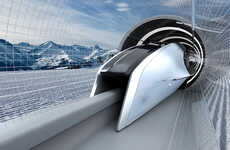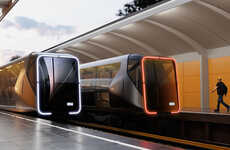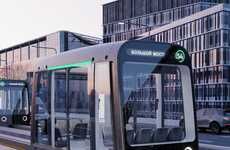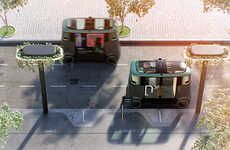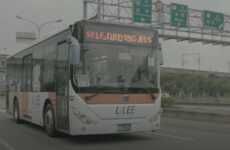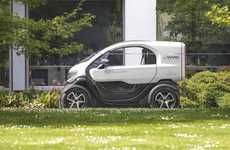
This Train From CRRC Zhuzhou Runs on Paint Lines Instead of Rails
Mary Van Puymbroeck — June 19, 2017 — Autos
References: tec.csrzic & psfk
This driverless train from Chinese company CRRC Zhuzhou is just one more way China is committed to lessening its environmental impact.
This Autonomous Rail Rapid Transit (ART) concept doesn't use rails but instead follows painted lines on the road for guidance. This autonomous 30-meter long vehicle can reach up to 70 km/h and operates exclusively on electricity. It can carry up to 500 passengers and uses sensors to scan the area around it for obstacles or potential points of collision. This driverless train is able to map out routes ahead of time and uses its on-board sensors to stay on route.
With the Paris Agreement, China committed to strict environmental objectives. Thus far, China has been putting in a significant effort to meet its targets. As subways become more difficult to build and the population grows, it is important to find environmentally friendly mass transportation solutions.
This Autonomous Rail Rapid Transit (ART) concept doesn't use rails but instead follows painted lines on the road for guidance. This autonomous 30-meter long vehicle can reach up to 70 km/h and operates exclusively on electricity. It can carry up to 500 passengers and uses sensors to scan the area around it for obstacles or potential points of collision. This driverless train is able to map out routes ahead of time and uses its on-board sensors to stay on route.
With the Paris Agreement, China committed to strict environmental objectives. Thus far, China has been putting in a significant effort to meet its targets. As subways become more difficult to build and the population grows, it is important to find environmentally friendly mass transportation solutions.
Trend Themes
1. Autonomous Rail Rapid Transit (ART) - Developing and implementing autonomous rail systems that can operate without traditional rails, using painted lines as guidance, presents disruptive innovation opportunities in the transportation industry.
2. Electric Driverless Trains - Creating driverless trains powered exclusively by electricity offers disruptive innovation opportunities in the transportation sector, reducing carbon emissions and promoting sustainable mass transportation.
3. Sensor-based Collision Avoidance - Leveraging advanced sensor technologies to enable driverless trains to scan the surrounding area, detect obstacles, and avoid collisions presents disruptive innovation opportunities for enhancing safety and efficiency in mass transportation.
Industry Implications
1. Transportation - The transportation industry can explore disruptive innovation opportunities in autonomous rail systems, electric trains, and sensor-based collision avoidance technologies to meet environmental goals and enhance urban mass transportation.
2. Infrastructure - The infrastructure sector can capitalize on disruptive innovation opportunities related to the development and integration of autonomous rail systems, electric train infrastructure, and sensor-based collision avoidance technologies for efficient and sustainable urban transportation.
3. Clean Energy - The clean energy industry can play a vital role in supporting disruptive innovation by providing sustainable power solutions for electric driverless trains, further contributing to the reduction of carbon emissions in the transportation sector.
2.5
Score
Popularity
Activity
Freshness


